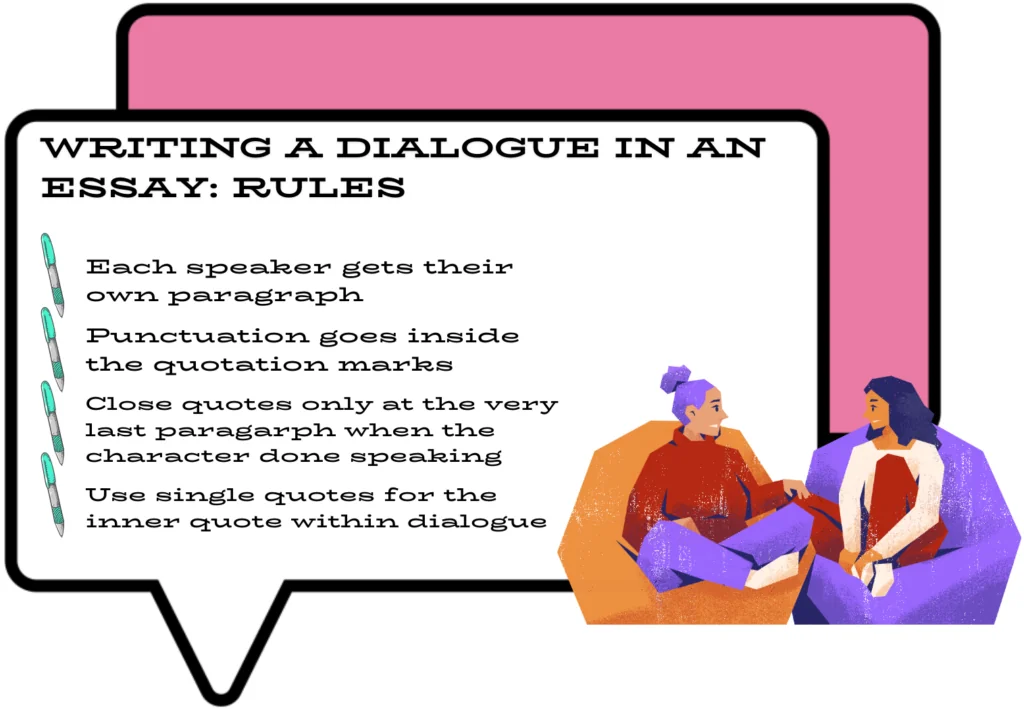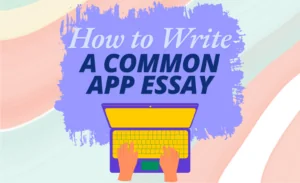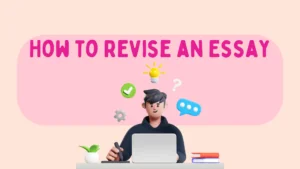Which one of you, dear readers, have ever thought about adding dialogue to their essays? Probably not many people. Why would anyone go beyond the standard writing requirements, right? Well, what if we told you that adding a lively conversation to your paper can make it truly stand out as it will be more dynamic and engaging? We know what you are thinking though: “But aren’t there, like, a lot of special rules to keep in mind?” To be fair, yes, there are some regulations as to how to write and format dialogue in essays. No need to worry though, as in this guide we’ll walk you through the basics, offer some handy tips, and show you how to make your characters’ voices pop.

✅ AI Essay Writer ✅ AI Detector ✅ Plagchecker ✅ Paraphraser
✅ Summarizer ✅ Citation Generator
What is a Dialogue: Definition & Different Types
Dialogue is the spoken words exchanged between characters in any form of creative writing, whether it’s a short story, novel, play, or even an essay. It’s where your characters’ true personalities, quirks, and emotions come to life, allowing them to interact and drive the story forward. Imagine you’re writing a scene where two friends are planning a surprise party:
“Are we sure she doesn’t know about this?” Alex whispered.
“Positive,” replied Jamie with a grin. “She thinks we’re all just going to the movies.”
There are two main types of dialogue:
- Inner – the conversation a character has in their own mind.
- Outer – the actual spoken conversation between two or more characters
Using inner dialogue can be a great way to show your characters’ thoughts and feelings without them speaking out loud. Oftentimes, such parts in the text are italicized to set them apart. Outer dialogue, on the other hand, is always enclosed in quotation marks.
Monologues
In addition to dialogue, there’s the monologue, which is essentially one persona’s long speech. This can be directed at other characters or just the audience. Think of it as your character’s moment to shine and spill all the tea about their deepest thoughts and plans.
Incorporating both types of dialogue and the occasional monologue can really make your writing pop, giving your characters a voice and making your story more engaging and dynamic.
Why Would You Need a Dialogue in an Essay?
It’s important to know why you add dialogue to your writing. If the only reason is to make your characters a bit more chatty, then you may want to rethink such a decision. A good dialogue well-written into the text is the one that serves a purpose. Here, there can de some variations as to why adding it might be needed.
First, dialogue is a fantastic way to characterize your characters. You get to show their personality, background, and emotional state just through how they talk. For example, a character who says, “I reckon it’s ’bout time we mosey on over,“ tells you a lot about their laid-back, perhaps Southern vibe, compared to someone who says, “Let’s proceed with haste.”
Dialogue also helps with exposition, sneaking in background information without dumping it all on the reader at once. Instead of a lengthy description, you could have your characters casually drop bits of the plot in their conversations. Picture this: Your protagonist learns about an upcoming music contest by overhearing a chat between coworkers, or your adventurous hero finds out about her destiny during a cryptic conversation with the town mystic.
Another perk of dialogue is that it makes your writing more immersive. It breaks up long chunks of prose and lets your reader hear different voices, not just your narrator droning on. Plus, these conversations can reveal how characters relate to each other, their environment, and the unfolding plot, often with a touch of subtext. Maybe one character’s formal language clashes with another’s slang, hinting at class differences or a shared history. A witty remark or a deep observation in dialogue can deliver nuances that a narrator’s description might miss.
How to Put Dialogue in an Essay
If you have decided to try and add a dialogue to one of your next essays, then you should first go over a couple of basic rules. Each speaker gets their own paragraph, even if they’re only saying one word. Indent these paragraphs, unless it’s the start of a chapter or after a scene break. Punctuation goes inside the quotation marks, and if you have a character speaking for multiple paragraphs, don’t close the quotes at the end of each one—just at the very end. If someone quotes another person within their dialogue, use single quotes for the inner quote.
Now, onto the steps.
| Step | What to do | Example/Recommendation |
|---|---|---|
| Determine the Purpose | Before you dive in, figure out why you’re adding dialogue. Knowing the purpose will guide how you write it. | Is it to reveal character traits? Do you want to provide exposition? Is it for plot advancement? |
| Choose the Characters | Decide which characters are speaking. | Keep the conversation relevant and focused by limiting the number of speakers to avoid confusion. |
| Use Quotation Marks | Begin and end your character’s speech with quotation marks. | This sets the characters’ words apart from the rest of your text. |
| Start a New Paragraph for Each Speaker | This makes it clear who is talking and keeps the conversation organized. | “I can’t believe we have a test tomorrow,” said Jenna. “Me neither,” replied Alex. “Guess I’ll be pulling an all-nighter.” |
| Write the Dialogue | Keep it natural and true to your characters. People don’t always speak in complete sentences or use perfect grammar, so feel free to break the rules a bit. | “I. Do. Not. WANT. to go back to boarding school!” Caleb shouted. *This makes his frustration palpable. |
| Use Dialogue Tags | Tags like “said,” “asked,” or “whispered” help identify who is speaking. | You can mix in some variety but stick to words that describe speech. |
| Add Action Beats | These are small actions or gestures that accompany the dialogue, making the scene more dynamic. | “I can’t do this anymore,” she said, shaking her head. |
| Remember the Setting | Don’t forget to include details about where the dialogue is happening. | This grounds your conversation in the story’s world. |
How to Format Dialogue in an Essay
Formatting dialogue in an essay is key to making your writing clear and engaging.
- The first rule is that each new speaker gets a new paragraph. This helps your readers easily follow who’s speaking.
“I can’t believe we have a test tomorrow,” said Jenna.
“Me neither,” replied Alex. “Guess I’ll be pulling an all-nighter.” - Punctuation is also important. Keep it inside the quotation marks, like this:
“I really shouldn’t have eaten that entire pizza,” he groaned. - When you have a character quoting someone else, use single quotes inside the double quotes:
“She told me, ‘You’re going to regret that,’ and she was right,” Mark admitted.
- For long speeches that span multiple paragraphs, skip the end quotation marks at the end of each paragraph, but start the new paragraph with opening quotes. Here’s an example:
“I remember the first time I saw the ocean. It was a day like no other.
“The waves were crashing, the sun was setting, and I felt a peace I had never known before.” - To show interruptions or actions, you can use an em dash:
“I was just going to say—”
“Look out!”
Or break up dialogue with actions to make it dynamic:
“I’m telling you,” she said, tossing her hair back, “this is the best idea we’ve ever had.”
Mistakes to Avoid When Writing Dialogues Into Your Essays
Okay, see, now you know how to quote dialogue in an essay and how to properly write it. So you are all settled…almost. Before you go on to writing, we would like to give you some more advice on which pitfalls to avoid during the process of crafting a dialogue.

Fors starters, avoid using a dialogue tag for every single line. Constantly adding “he said” or “she asked” can become repetitive and disrupt the reader’s flow. Once it’s clear who’s speaking, many lines can stand alone. On the flip side, don’t skimp on tags to the point where your readers are lost about who’s talking. Balance is key—use enough tags to keep the dialogue clear but not so many that it feels cluttered.
Another mistake is making characters’ speech too dense or unrealistic. In real life, people don’t always speak in perfect sentences, and your characters shouldn’t either. Keep it natural and readable. Also, be cautious of anachronisms; your medieval knight probably shouldn’t say, “Dude, what’s up?” unless you’re going for a humorous twist.
Avoid eye dialect, which is writing out mispronunciations phonetically. This can be hard to read and sometimes offensive. Stick to simple and recognizable variations like “gonna” instead of “going to.” Lastly, don’t overuse characters’ names in dialogue. After all, people don’t usually repeat each other’s names in every sentence during a conversation.
Conclusion
A dialogue can be a powerful writing tool to make an interesting twist in your essay. And it shouldn’t necessarily be long or very elaborate. The only two things it needs to be is a) natural, and b) believable. And, if you follow our advice, you will easily be able to create an engaging dialogue that adds nuance to your writing. Just don’t forget to format it properly too!
FAQ
Follow us on Reddit for more insights and updates.






Comments (0)
Welcome to A*Help comments!
We’re all about debate and discussion at A*Help.
We value the diverse opinions of users, so you may find points of view that you don’t agree with. And that’s cool. However, there are certain things we’re not OK with: attempts to manipulate our data in any way, for example, or the posting of discriminative, offensive, hateful, or disparaging material.